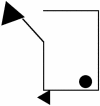Impaired spontaneous anthropomorphizing despite intact perception and social knowledge
- PMID: 15123799
- PMCID: PMC409945
- DOI: 10.1073/pnas.0308220101
Impaired spontaneous anthropomorphizing despite intact perception and social knowledge
Abstract
Humans spontaneously imbue the world with social meaning: we see not only emotions and intentional behaviors in humans and other animals, but also anger in the movements of thunderstorms and willful sabotage in crashing computers. Converging evidence supports a role for the amygdala, a collection of nuclei in the temporal lobe, in processing emotionally and socially relevant information. Here, we report that a patient with bilateral amygdala damage described a film of animated shapes (normally seen as full of social content) in entirely asocial, geometric terms, despite otherwise normal visual perception. Control tasks showed that the impairment did not result from a global inability to describe social stimuli or a bias in language use, nor was a similar impairment observed in eight comparison subjects with damage to orbitofrontal cortex. This finding extends the role of the amygdala to the social attributions we make even to stimuli that are not explicitly social and, in so doing, suggests that the human capacity for anthropomorphizing draws on some of the same neural systems as do basic emotional responses.
Figures



References
-
- Scholl, B. J. & Tremoulet, P. D. (2000) Trends Cognit. Sci. 4, 299-309. - PubMed
-
- Guthrie, S. E. (1995) Faces in the Clouds: A New Theory of Religion (Oxford Univ. Press, Oxford).
-
- Heider, F. & Simmel, M. (1944) Am. J. Psychol. 57, 243-259.
-
- Hashimoto, H. (1966) J. Child Dev. 2, 3-26.
Publication types
MeSH terms
Grants and funding
LinkOut - more resources
Full Text Sources

